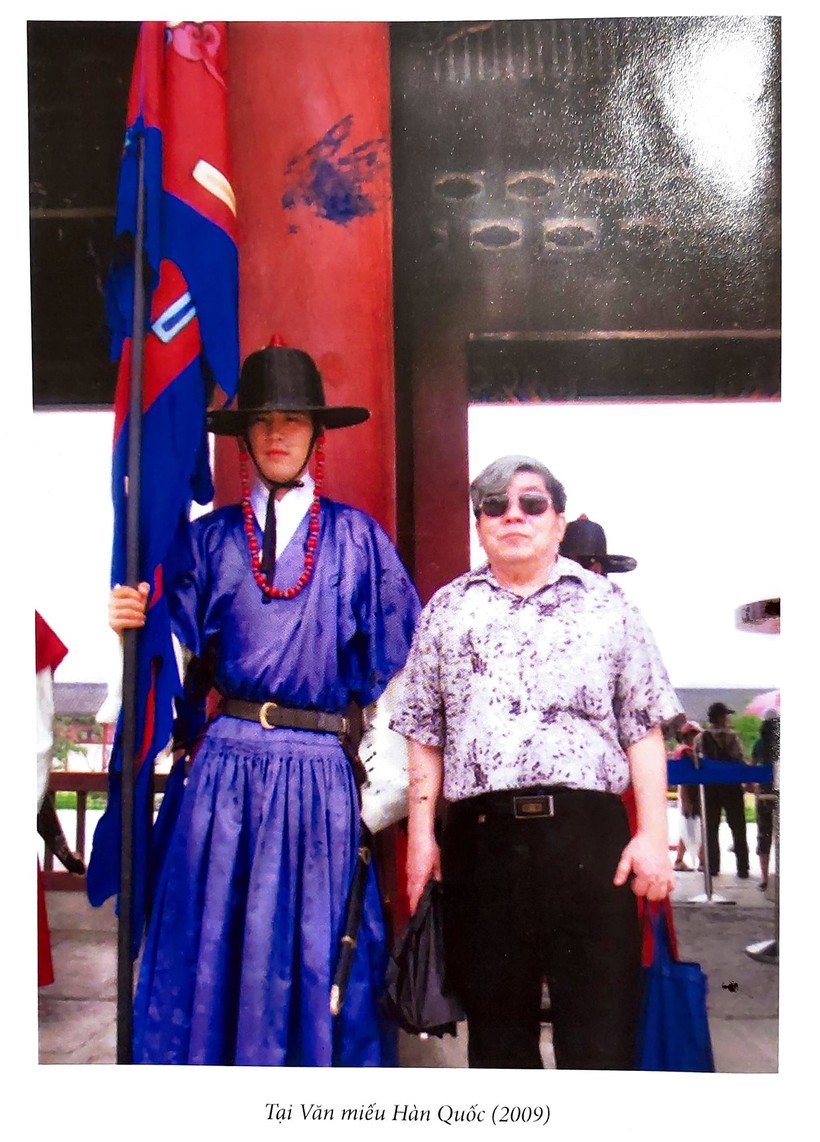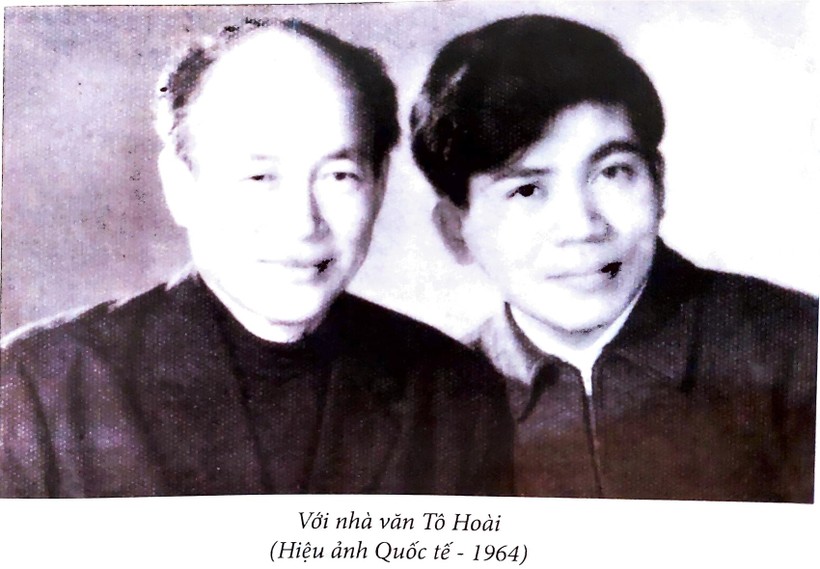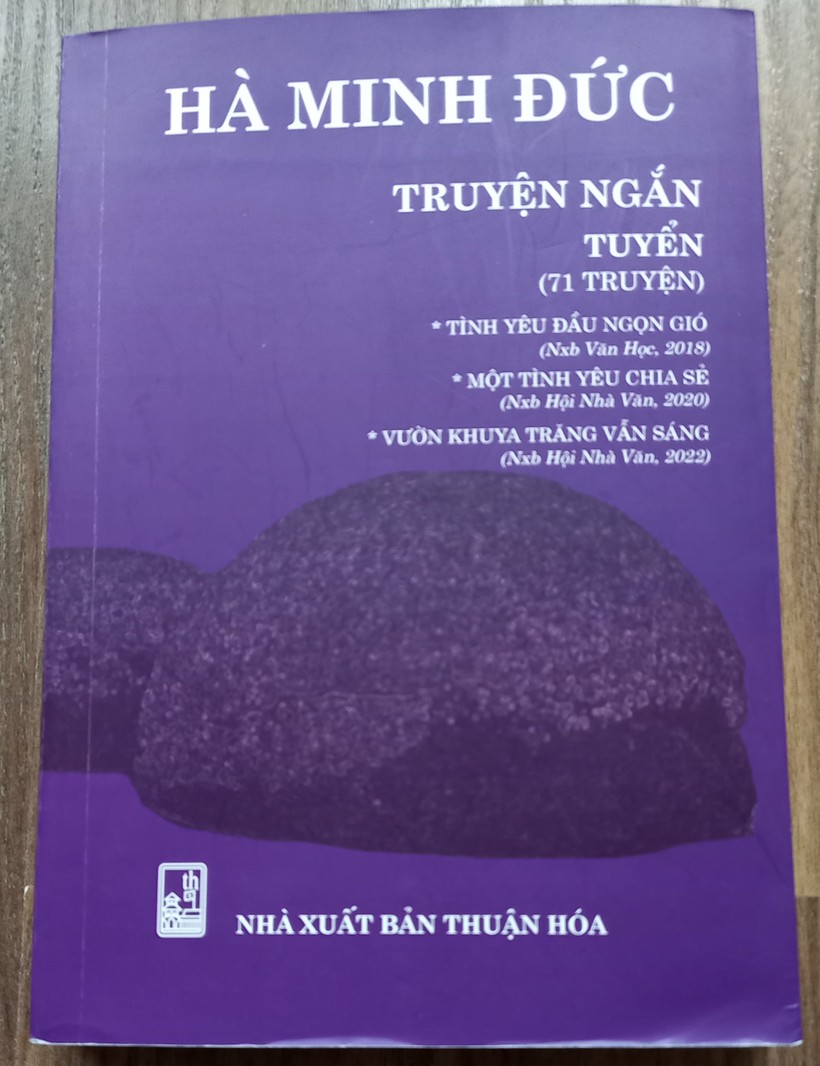Professor and People's Teacher Ha Minh Duc is an exemplary role model of unwavering dedication and tireless effort in the cause of educating people; a sharp and loyal literary theorist committed to the national cultural cause; and a writer who diligently researched and created, achieving many successes that contributed to building a national literature rich in identity.
He held many important positions: Head of the Journalism Department (now the Institute of Journalism and Communication Training), University of Social Sciences and Humanities; Director of the Institute of Literature (Vietnam Academy of Social Sciences, now the Vietnam Academy of Social Sciences); Member of the Central Council for Literary and Artistic Theory and Criticism; Member of the National Education Committee. In his personal life, he was a gentle, humble, amiable, compassionate, and optimistic person.
Village elder of literatureProfessor, People's Teacher, and writer Ha Minh Duc was born on May 3, 1935, in Vinh An commune, Vinh Loc district, Thanh Hoa province. He belonged to the first generation of lecturers at Hanoi University, now the University of Social Sciences and Humanities (Vietnam National University, Hanoi), when he was just 22 years old, and is now over 90 years old. He has been awarded the following prestigious honors: the Second Class Anti-American Resistance Medal and the First Class Labor Medal.
With over 70 years of continuous teaching, research, and creative work, Professor Ha Minh Duc has contributed to the development and expansion of the country's culture and arts.
He was honored with the State Prize for Science and Technology in 2000; the State Prize for Literature and Arts in 2001; and the Ho Chi Minh Prize for Science and Technology in 2010. His name was proudly included in the list of: "500 Outstanding Asian Figures of the Early 21st Century" (Author John Pellam - World Biographical Forum, published 2002) and the book: "2,000 Famous Scholars of the 21st Century" (International Biographical Center, published 2005).
Ninety works are the literary output of Professor, People's Teacher, and writer Ha Minh Duc, published over the past 62 years (1961 - 2023), beginning his career with "Nam Cao - an outstanding realist writer" (Research, 1961) to "Selected Short Stories" (2023).
Previously, readers knew Professor Ha Minh Duc as a sharp and insightful literary researcher, theorist, and critic. However, from "Going Through an Autumn" (Poetry, 1999) to the present day, he has made his mark as a writer with admirable longevity, navigating the boundaries of both poetry and prose (12 poetry collections, 10 essay collections, 4 short story collections).
At the age of 90, the veteran of the literary world still surprises and impresses readers with his writing prowess upon the release of his "Selected Short Stories" (71 stories). Seventy-one – this number may be coincidental, but it could also be inevitable – I speculate – given the careful, meticulous, and discerning nature (to use the words of his teaching and writing colleagues) of writer Ha Minh Duc.
The author's implication is perhaps that 71, when read in reverse, is 17, as the folk saying goes, "at seventeen, one can break a buffalo's horn" (?!). From three short story collections, "Love at the First Wind" (2018), "A Shared Love" (2020), and "The Moon Still Shines in the Garden at Night" (2022), the author "gathered" 71 stories in the collection "Selected Short Stories" (2023).
In terms of literary research, theory, and criticism, Professor Ha Minh Duc is a writer with a "literary flair," "burning with passion to the very last drop." Reading Professor Ha Minh Duc's "Selected Short Stories," I find that same flair, that same passion, still full and fervent in the 90th work of his literary career.
Reading Professor Ha Minh Duc's works, from research, theory, and criticism to creative writing (poetry, essays, short stories), one can see that his writing is distilled from a wealth of life and cultural experience. It can be said that this is the fundamental foundation for a literary career.
His memoir "Searching for Beauty" (Literature Publishing House, 2020) provides further evidence that the author's process of searching for and discovering beauty ("Beauty is life") is linked to an increase and enrichment of creative emotions, but the foundation and root of the act of writing is culture.
Multifaceted, multi-faceted, and passionate.
Professor Ha Minh Duc's rhythmic writing style gives his short stories a gentle, profound, and subtle quality when depicting the truths of the human soul.
Reading Professor Ha Minh Duc's short stories, I suddenly had a connection: Hanoi is one of the world's capitals with the most lakes, approximately 100 (according to VnExpress). Lakes (both natural and artificial) act as "lungs," regulating the climate and weather, creating green spaces for a historically significant and culturally rich region known as Thang Long - Dong Do - Hanoi.
The seventy-one short stories in Professor Ha Minh Duc's anthology are like seventy-one calm, clear lakes; if there are any ripples, they are only gentle waves.
Professor Ha Minh Duc's short stories, of course, are not like towering mountains, long rivers, or vast oceans; nor are they about to erupt like volcanoes or as violent as tsunamis or earthquakes.
It seems to belong to the lyrical narrative tradition (with many poetic qualities), an extension and adaptation of the achievements of Thạch Lam, Hồ Dzếnh, Nguyễn Thành Long, Anh Đức, Nguyễn Bản, Đỗ Chu... It possesses the quality of the ability to reconcile contradictions, soothe pain, balance the mindset caused by loss, and compensate for the shortcomings of life, as the saying goes, "no one is perfect."
Love is a powerful magnet that creates a vast "magnetic field" in Professor Ha Minh Duc's short stories. These stories encompass themes like "a shared love," "love at the first breeze," "the love story of a young soldier," "exchanging scrap metal for love," "a declaration of love," "a defensive love," "a tragic love," "love in the straw," "first love," "when did love come from?"... Even stories without the word "love" in their titles are overflowing with emotion, such as "The Rhythm of the Ox Cart," "Irony," "Who Prays for Wealth and Children," "Mismatched Couple," "The Suffering of a Woman with a Lucky Fate," "A Woman's Luck is Not as Good as a Woman's Fate," "The Story of O Buoi in Na Village"...
The author is experienced, polite, sophisticated, and stylish in life, yet when writing about love, he does so in a simple, gentle, tender, and nurturing way, encouraging what is pure, virtuous, and perfect.
I always thought the author belonged to the Romantic school, aiming for beauty, light, and "pure air." There's a joyful quality, but it doesn't reach the point of euphoria when writing about love. There are hints of sensuality (sex), but it's not overtly displayed; the "animal" side is reversed, while the "human" side is still carefully considered.
Reading Professor Ha Minh Duc's short stories clearly reveals the movement of literature along a path from favoring the "collective" to focusing on the "individual" and exploring "being." The people/characters in Professor Ha Minh Duc's short stories are like "fragments."
The entire collection of stories resembles a symphony of fragments within fragments. The characters in Professor Ha Minh Duc's short stories, regardless of their political stances, social status, education, economic conditions, or gender, all share a common thread – love.
In short stories, authors often write about the unfulfilled nature of love, perhaps thus evoking a sense of regret in the reader, much like the lines of the poet Ho Dzenh: "Love loses its joy when the vows are fulfilled / Life is only beautiful when it remains unfinished..." (Hesitation).
The characters in Professor Ha Minh Duc's short stories are often complex, multifaceted, and sentimental (perhaps that's why they are all the more lovable), just like their "spiritual father."
Illuminating the truths of the soul

Professor and People's Teacher Ha Minh Duc at the Korean Temple of Literature. Photo: Bui Viet Thang - Provided by the author.
It must be said that the strength of Professor Ha Minh Duc's short stories does not lie in the plot (thrilling, suspenseful, exciting, novel details; haunting endings or dramatic situations...).
Most of the stories are quiet, unhurried, and subtly present in their structure and style—a type of writing rich in rhythm. I think, in this case, this excludes a few stories that blend memoir (narrative memoir), or have the characteristics of essays, or even literary criticism.
According to many readers, the most outstanding and appealing aspect of the short stories in this collection lies more in the literary style than in the narrative. I also understand that when writing short stories, Professor Ha Minh Duc often entrusted them to his literary friend Ma Van Khang and readily listened to his colleagues' comments.
While writer Ma Van Khang's writing style is like the waves of the sea, "fierce and gentle," Professor Ha Minh Duc has a way of touching people's hearts in a more intimate manner. Sometimes it seems like he's just telling "everyday stories" (like "The Man Counting Crabs in a Hole," "Irony," "A Night on the Thong Nhat Train," "An Unexpected Story"...).
It seems the author tends to recreate the "stillness" to speak of the "movement" of social life, especially the spiritual life of people and the human psyche of the era.
Professor Ha Minh Duc's rhythmic writing style gives his short stories a gentle, profound, and subtle quality when depicting the truths of the human soul. The story "The Rhythm of the Buffalo Cart" is a prime example.
A young university lecturer and a young female student hitch a ride on an ox cart back to their school, which had been evacuated during the war. There were hardly any major incidents, only a few ordinary events along the way. Outwardly, everything seemed completely calm. But inwardly, the young lecturer was experiencing a turbulent period.
The teacher already had a family, a wife and children. But now, standing beside a fresh, pure, and saintly beauty in the female student, he couldn't help but feel a pang of emotion and a tremor in his heart. Life, in its reality, has moments of wavering feelings, of "being outside of marriage."
However, the teacher character in the story does not overstep the boundaries of acceptable limits, nor does he go to the extreme of emotion, because he knows how to restrain himself for the honor of a respectable and upright man. The story of the teacher and student's night hitchhike is elevated by a poetic and rhythmic writing style: “As dawn approached, the air grew colder, and fog from the surrounding mountains rolled towards the village. Under the moonlight, the grass and trees seemed both dark purple and silvery white. He urged us to get on the cart again. The ox cart slowly began to move, steadily in rhythm with the swing. Cold fog rushed into the cart. Lan nestled against me.”
The slow pace of the sentence seems to match the slow pace of the buffalo, which is already "old" and "thin," and the cart, which is also "old." The reader gets the feeling that the following sentence was written by a genuine romantic writer from long ago: "It was this dilapidated cart that helped us overcome the difficulties of the night and lulled me into a small dream, adding more poetry and meaning to life."
The statement "Literature is the art of language" is very apt in the case of the writing of Professor, People's Teacher, and writer Ha Minh Duc.


